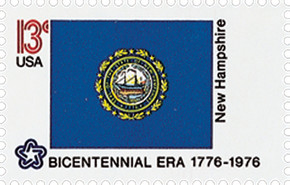
U.S. 1635
1976 New Jersey State Flag
State Flags
American Bicentennial Series
• First time a sheet 50 had all different stamp designs
• Part of the American Bicentennial Series
Stamp Category: Commemorative
Series: American Bicentennial Series
Value: 13¢ First-class postage rate
First Day of Issue: February 23, 1976
First Day City(s): Washington, DC
Quantity Issued: 8,720,100 (panes of 50)
Printed by: Bureau of Engraving and Printing
Printing Method: Photogravure
Format: Sheet of 50
Perforations: 11
Why the stamp was issued:
The United States Postal Service celebrated the American Bicentennial with a full pane of the Union’s fifty state flags.
About the stamp design:
New Jersey's State Flag is composed of a buff-colored field with the state coat of arms in the middle. The coat of arms consists of a horse’s head, helmet, and three plows which symbolize the state’s self-governance and agriculture history. Liberty stands to one side of the coat of arms and Ceres, the Roman goddess of agriculture on the other. During the Revolutionary War, George Washington picked the buff and dark blue colors.
About the printing process:
Printed by the Bureau of Engraving and Printing on their seven-color Andreotti gravure press (601) which was their work horse for multicolored stamps.
About the American Bicentennial Series:
In the 1970s, America celebrated its 200th anniversary with hundreds of national events commemorating the heroes and historic events that led to our nation’s independence from Great Britain. The U.S. Postal Service issued 113 commemorative stamps over a six-year period in honor of the U.S. bicentennial, beginning with the American Revolution Bicentennial Commission Emblem stamp (U.S. #1432). As a group, the Bicentennial Series chronicles one of our nation’s most important chapters, and remembers the events and patriots who made the U.S. a world model for liberty.
Several of the stamps honored colonial life – craftsmen and communication. Other stamps honored important battles including Lexington and Concord, Bunker Hill, and Saratoga. Significant events such as the Boston Tea Party, the meeting of the First Continental Congress, and the Declaration of Independence were featured as well. The stamps also honored many significant people such as George Washington, Sybil Ludington, Salem Poor, and the Marquis de Lafayette.
Many of the stamps feature classic artwork. For instance, the set of four souvenir sheets picture important events recreated by noted artists such as John Trumbull. The Bicentennial Series also includes an important US postal first – the first 50-stamp se-tenant – featuring all 50 state flags. The format proved to be popular with collectors, and has been repeated many times since.
The American Bicentennial Series is packed with important US history – it tells the story of our nation’s fight for independence through stamps.
History the stamp represents:
On December 18, 1787, New Jersey became the third state to ratify the Constitution and join the Union.
New Jersey’s first inhabitants were Native Americans who belonged to the Delaware tribe of the Algonquian family. Experts estimate that about 8,000 Indians lived in the region when European settlers first arrived. In 1524, Giovanni da Verrazano, an Italian navigator serving France, became the first European to explore the New Jersey coast.
In 1630, the Dutch formed an outpost in Pavonia (now part of Jersey City). However, Indian attacks prevented the establishment of a permanent settlement until 1660, when the Dutch built the fortified town of Bergen (also part of modern-day Jersey City). Bergen was New Jersey’s first permanent European settlement.
When the Revolutionary War began in Massachusetts in 1775, large numbers of New Jersey colonists joined on both sides. The colony’s location between the cities of New York and Philadelphia made it a major battleground. Nearly one hundred military engagements were fought on New Jersey soil. The most important of these were the battles of Trenton in 1776, Princeton in 1777, and Monmouth in 1778. Before the Battle of Trenton, General George Washington made his legendary crossing of the Delaware River on Christmas night.
During the Revolution, two New Jersey cities served as the temporary national capital. Princeton was the national capital from June 30, 1783, until November 4, 1783, and Trenton from November 1, 1784, until December 24, 1784.
On July 2, 1776, New Jersey declared its independence from Great Britain and adopted its first constitution. It ratified the Articles of Confederation (the forerunner to the US Constitution) on November 26, 1778. On December 18, 1787, New Jersey ratified the United States Constitution, and became the third state to join the Union.















